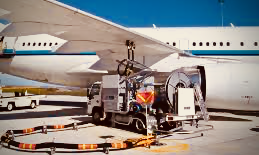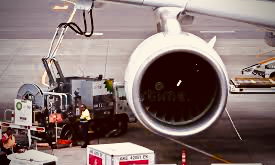VAMOSKIES: Fueling a Resurging Surcharge.
VamoSkies: Upper Level Turbulence (Premise).
Psst, jet fuel prices have jumped upwards of 50% in the past year—pass it on…
Which is what the airlines intend on doing, only they say not right away. 
Rigghhttt, roger that. As if carriers will be content to cut their profit forecasts and refrain from “being paid for the cost of the product”, as one Delta Airlines official recently put it.
Pricing Power Plays.
For a majority of airlines, fuel is the largest operational expense—per barrel prices, incidentally, monitored daily by S&P Global Platts index. With relatively cheaper PBL levels in recent years, carriers lowered domestic fares, while adding routes and fleet capacity.
At the same time, they boosted their bottom lines through ever-increasing fees on seating, baggage, etc., as well as managing any fuel price moves via hedging strategies (on oil derivative contracts) and the like. Some carriers even continued to expand capacity amid a high demand/full-load consumer market such as today’s summer travel season—resulting in greater jet fuel needs.
Capacity vs. Costs: A Tricky Balance.
But now comes benchmark Brent crude rising and OPEC threatening to recalibrate oil production, with airline scales tipping away from capacity growth to cutting costs. Historically, fuel price upticks have also prompted stand-alone per-ticket surcharges, as per-BBL ‘distillate’ costs continue to soar.
So buckle up, Vamigrés, for carrier execs are already assuring Wall Street they are confident they can recoup at least 75% of fuel price increases through a series of small, incremental tack-ons—i.e., the boiling frog approach—to minimally impact revenue per available seat mile.
Just maybe not right away, they maintain. Still, fuel charges are known to creep in suddenly, if not stealthfully—along with increased fees for security, flight changes, checked baggage, Wi-Fi, meals and beverages (altogether up to 73% of total U.S. airline operating revenue in 2018). While cost cutting may result in fewer flights and scheduled routes.
This, despite the fact that most airline fleets feature more fuel-efficient Boeing and Airbus craft than ever before. Or in the face of a 2012 U.S. Department of Transportation ‘crackdown’ requiring fuel surcharges to be pegged to the actual market cost per barrel; admittedly, Trump era enforcement remains to be seen here.
 So airline industry are projections are: $2-$5 per flight gouges, with international flights seeing 6% to upwards of 15% per ticket hikes—ostensibly coming this fall, if not sneaking in far sooner. In fact, Delta has already raised fares 4%, and plans to begin trimming routes come fall.
So airline industry are projections are: $2-$5 per flight gouges, with international flights seeing 6% to upwards of 15% per ticket hikes—ostensibly coming this fall, if not sneaking in far sooner. In fact, Delta has already raised fares 4%, and plans to begin trimming routes come fall.
Time will quickly tell whether investors dictate the rate of resurfacing fare surcharges, or market forces (namely traveler demand, price consciousness and carrier competition) can continue downward pressure on fares.
In the meantime, Vamigré will keenly, comparatively track these carrier nicks and bites—with particular focus on less competitive routes in and out of smaller airports and destinations.
Call it holding carriers’ fares and fees to the fire. And you can pass that on…
